![]()
![]()
![]()
Use LEFT and RIGHT arrow keys to navigate between flashcards;
Use UP and DOWN arrow keys to flip the card;
H to show hint;
A reads text to speech;
36 Cards in this Set
- Front
- Back
- 3rd side (hint)
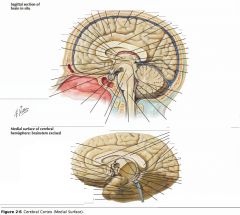
What are the divisions of the Diencephalon? |

1. Thalamus
2. Subthalamus, 3. Hypothalamus, and 4. Epithalamus. |
|
|
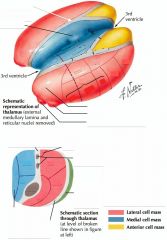
What collection of internal cell fibres of the Thalamus is indicated by the white arrow?
|

The Internal Medullary Lamina.
|
|
|
|
How many nuclear groups does the Thalamus divide into? |
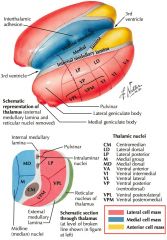
Three:
1. Anterior, 2. Medial, and 3. Lateral Nuclear Groups. |
|
|
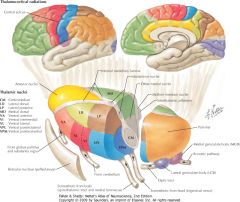
What is a "specific" thalamic nucleus? |

It is a nucleus receiving input from defined sensory or motor pathway that projects to restricted, clearly delineated cortical regions. |
|
|
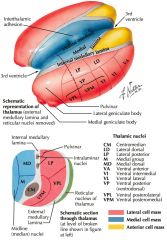
Where are all of the Specific Thalamic Nuclei located?
|

They are all in the Lateral Nuclear Group. |
|
|

What is the name of the white matter surrounding the Thalamus?
|

The External Medullary Lamina.
|
|
|
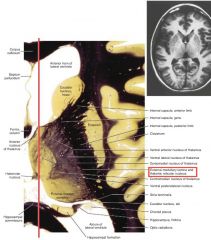
What types of fibres are found in the External Medullary Lamina?
|

It contains:
1. Thalamocortical, and 2. Corticothalamic Fibres. So, fibres to and from the cortex and thalamus. |
|
|
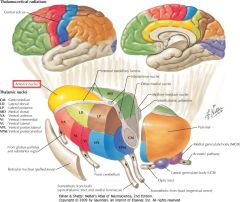
What system is the Anterior Nuclear Group considered a part of?
|

It's considered part of the Limbic System.
|
|
|
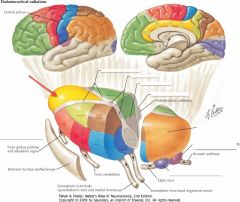
What group of nuclei is indicated by the red arrow?
Where does it receive afferents from? Where does it project to? |

The Anterior Nuclear Group.
It receives afferents from the Mammillary Bodies. Its axons project to the Cingulate Gyrus. |
|
|
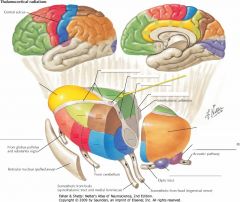
Which Thalamic Nucleus is indicated by the yellow arrow?
|

The Medial Dorsal (or Dorsomedial) Nucleus.
|
|
|
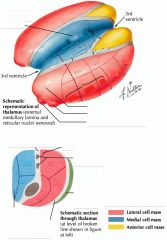
What is the largest nucleus in the Medial Cell Mass of the Thalamus?
|

The Medial Dorsal (or Dorsomedial) Nucleus
|
|
|
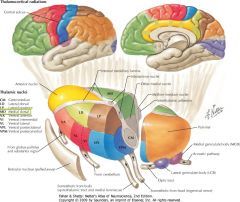
Where does the Dorsomedial (or Medial Dorsal) Thalamic Nucleus receive its afferents from?
|

The Amygdala and the Corpus Striatum (among others).
(Amygdala efferent pathways shown) |
|
|
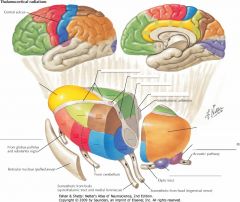
Where does the Dorsomedial Nucleus project its axons too?
What is it thought to be involved with? |

It is connected (reciprocally) to the Prefrontal Cortex.
It is thought to be involved in affective states, judgement, and some aspects of memory. |
|
|
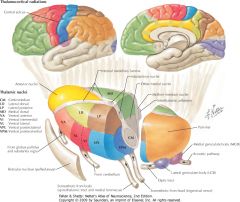
What are the two tiers of the Thalamic Lateral Nuclear Group?
Which tier contains Specific Nuclei? |

The two tiers are the:
1) Dorsal (LD, LP, and Pulvinar), and 2) Ventral (VA, VL, VI, VL, VPM, VPL, MGB, LGB) tiers. The Ventral Tier consists of specific nuclei. |
|
|
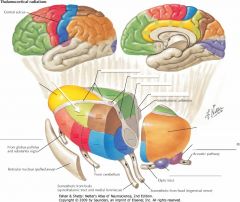
Which Thalamic Nucleus is indicated by the white arrow?
|

The Lateral Dorsal Nucleus
|
|
|
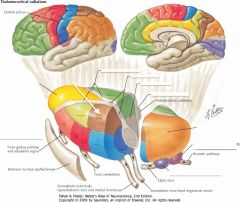
Which Thalamic Nucleus is indicated by the white arrow?
|

The Lateral Posterior Nucleus
|
|
|
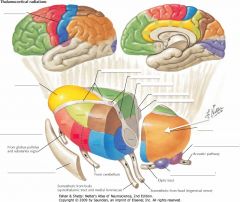
Which Thalamic Nucleus is indicated by the white arrow?
|

The Pulvinar
(from latin for "cushion") |
|
|
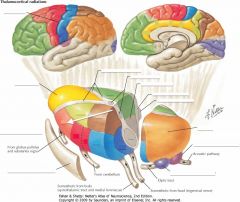
Which Thalamic Nucleus is indicated by the white arrow?
|

The Ventral Anterior Nucleus.
|
|
|

Which Thalamic Nucleus is indicated by the white arrow?
|
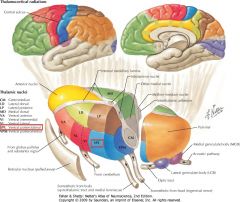
The Lateral subdivision of the Ventral Posterior Nucleus
(or Ventroposterolateral nucleus) |
|
|
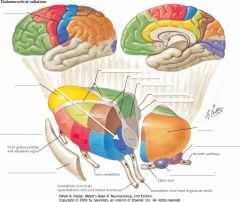
Which Thalamic Nucleus is indicated by the white arrow?
|

The Medial subdivision of the Ventral Posterior Nucleus.
(or, the Ventral Posteromedial) |
|
|
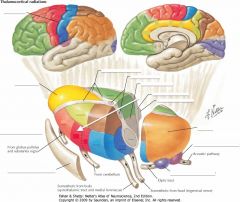
Which Thalamic Nucleus is indicated by the white arrow?
|

The Ventral Lateral Nucleus.
|
(The Ventral Intermedial is not distinguished in the lab manual)
|
|
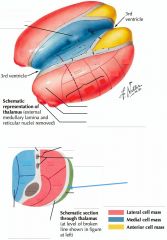
Which Thalamic Nucleus is indicated by the blue arrow?
|

The Reticular Nucleus,
located between the external medullary lamina and the Internal Capsule. |
|
|
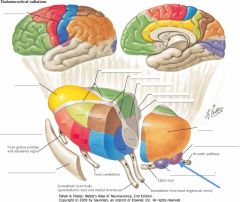
Which Thalamic Nucleus is indicated by the blue arrow?
|

Medial Geniculate Body
(From latin: "genu" knee) |
|
|
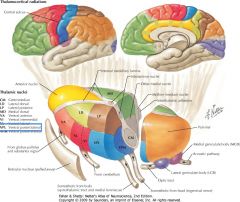
What input does the Ventral Posterolateral Nucleus receive?
|

It receives somatosensory pathways from the Medial Lemniscal and Spinothalamic pathways.
|
|
|
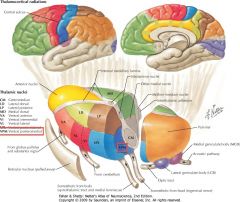
What input does the Medial division of the Ventral Posterior Thalamic Nucleus receive?
(The Ventral Posteromedial Nucleus) Where does it project to? |

Trigeminothalamic Pathways.
It projects to the Postcentral Gyrus. |
It also receives the taste pathways from the Rostral Nucleus Solitarus, and projects to the Sensory Cortex. (14.11, Netter Neuroanatomy)
|
|
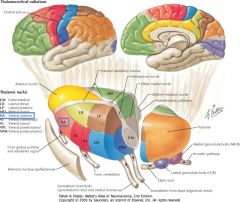
Where does the Ventral Anterior Nucleus receive input from?
What region of the Neocortex is it connected to? |

The Globus Pallidus and the Substantia Nigra.
It is (reciprocally) connected to the Frontal Lobe, particularly the Motor Cortex. |
|
|
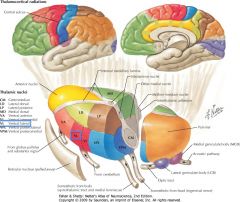
Where does the Ventral Lateral Thalamic Nucleus receive its inputs from?
What regions of the Neocortex is it connected to? |

It receives input from the Globus Pallidus and the Cerebellum (Dentate Nucleus, not shown).
It is connected to motor and pre-motor regions of the Frontal Lobe. |
It also receives input from the Substantia Nigra.
|
|

Where does the Lateral Geniculate Body (LGB) receive input from?
What part of the Neocortex is it connected to? |

It receives visual input via the Optic Tract.
It projects to the Visual Cortex in the ipsilateral Occipital Lobe. |
|
|
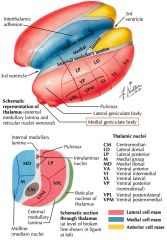
Where does the Medial Geniculate Body receive input from?
What area of the Neocortex does it connect with? |

It receives auditory input via the Inferior Colliculus.
It's connected to the Auditory Cortex in the Temporal Lobe. |
|
|
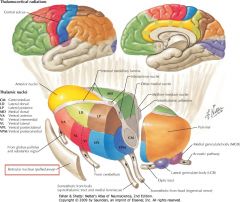
What inputs does the Reticular Nucleus receive?
Where does it project to? |

It receives collateral fibres of Thalamocortical and Corticothalamic fibres.
It only projects to other Thalamic Nuclei, regulating their functions. (it is the only thalamic nucleus to not project to the Cortex) |
|
|
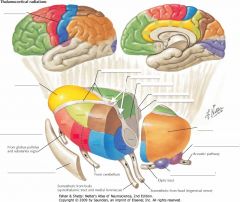
What Thalamic Nuclei are indicated by the white arrows?
Where do they receive inputs from? What cortices do they connect to? |

The Intralaminar Nuclei.
They receive input from a variety of sources, including the brainstem Reticular Formation, and are connected to the Frontal and Parietal Cortices. They are thought to influence alertness and levels of consciousness. |
|
|
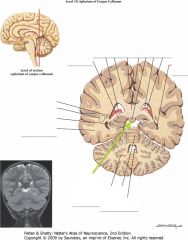
What structure is indicated by the green arrow?
What part of the Diencephalon is it a part of? |

The Pineal Body.
It's part of the Epithalamus. |
|
|
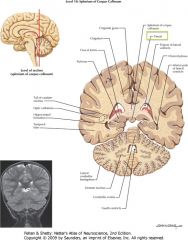
What is the Pineal Body involved in?
|

It secretes melatonin, involved in regulating sleep-wakefulness cycles, as well as gonadal maturation.
|
|
|
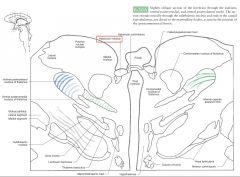
Where do the Habenular Nuclei receive input from?
|

They receive input from the Septal Nuclei via the Stria Medullaris Thalami.
|
|
|
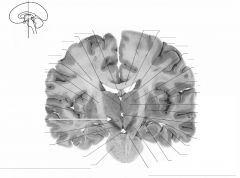
What nucleus is indicated by the white arrow? What section of the Diencephalon is it a part of?
What activity is it involved with? |

The Subthalamic Nucleus, of the Subthalamus.
It is involved in motor control. |
Lesions in the Subthalamic Nucleus can produce Hemiballismus.
|
|
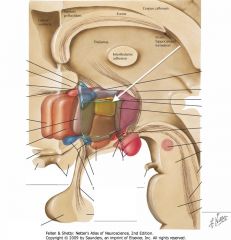
What section of the Diencephalon is indicated by the white arrow?
(all the coloured bits) Broadly, what is it involved in? |

The Hypothalamus.
It is involved with the control of visceral function and the maintenance of homeostasis, while being intimately associated with the Limbic System. |
|

